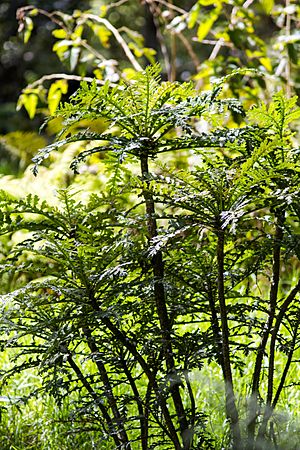Shipman's cyanea facts for kids
Quick facts for kids Shipman's cyanea |
|
|---|---|
 |
|
| Conservation status | |
| Scientific classification | |
| Genus: |
Cyanea
|
| Species: |
shipmanii
|
Cyanea shipmanii is a very rare flowering plant. It belongs to the bellflower family. People often call it Shipman's cyanea. In Hawaiian, it's known as haha.
This plant is endemic to the island of Hawaii. This means it grows naturally nowhere else in the world! You can only find it on the windy slopes of Mauna Loa and Mauna Kea. The United States government lists it as an endangered species. This means it is at high risk of disappearing forever.
Contents
Meet the Shipman's Cyanea
What Does It Look Like?
This special plant is a fragile shrub. It can grow up to four meters (about 13 feet) tall. It has only a few branches. The leaves are very interesting. They are deeply divided into many tiny parts. This makes them look a bit like fern leaves.
Young plants have weak, thorn-like bristles. These bristles cover their leaves and stems. Older plants also have these bristles on their lower parts. The plant produces many greenish-white flowers. These flowers grow in clusters. After flowering, it makes small orange fruits. Each fruit holds many tiny seeds.
Where Does It Live?
The Shipman's cyanea naturally lives in moist native forests. It prefers volcanic soil that is well-developed. You can find it at high elevations, usually around 5,000 to 6,000 feet up the mountains.
Why Is It Endangered?
This plant is in danger of extinction. Its home is being destroyed. Here are some of the main reasons:
- Logging: Cutting down trees removes the forest where it lives.
- Cattle Ranching: Cows can eat or trample young plants.
- Introduced Species: New plants brought to Hawaii can take over the habitat. They compete with the native plants for space and sunlight.
- Feral Pigs: Wild pigs dig up the ground. This damages the plant's roots and changes the soil.
Helping the Shipman's Cyanea
Scientists are working hard to save this rare plant. New groups of these plants are sometimes found in the wild. But these groups usually have only a few individual plants.
People are also planting hundreds of nursery-grown Shipman's cyanea. This is called "outplanting." However, these new plants have very little genetic diversity. This means they are all very similar. They come from only a few original wild plants. It's not yet clear if these new plantings will create strong, self-sustaining wild groups. Only about 37% of young plants survive when they are planted in their natural home.


